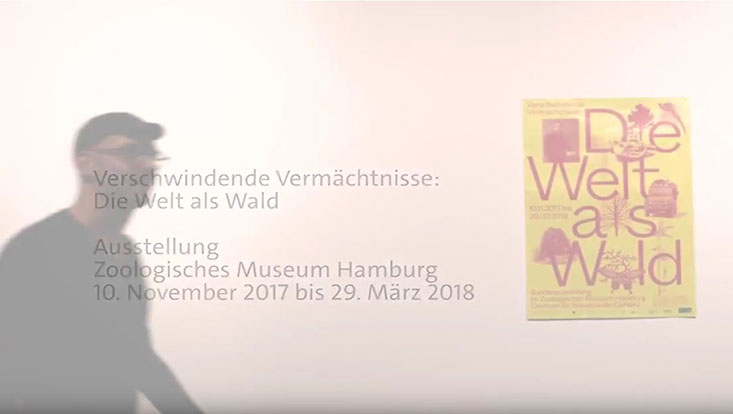Opening of the special exhibition
From November 10, 2017 to March 29, 2018, the LIB at the Museum der Natur Hamburg - Zoologie will present the special exhibition "Vanishing Legacies: The World as Forest." For this period, audiovisual installations, photographs, films and sculptures by contemporary artists transform the exhibition hall into the endangered habitat forest.
This extraordinary exhibition project draws connections from the expeditions of naturalist Alfred Russel Wallace in the 19th century to the current destruction of rainforests in Southeast Asia and South America. The artistic positions and curatorial assemblages presented in the exhibition contradict a romantic image of untouched nature and instead ask about the legacies that remain, in the face of the ongoing destruction of highly complex ecosystems. In addition to fine art, exhibits from the scientific collections of CeNak as well as the Herbarium Hamburgense will be on view. Eight of the 13 artistic positions were created especially for the special exhibition, while others have already received worldwide recognition in renowned museums, galleries and biennials.
The following artists are represented in the exhibition:
Maria Thereza Alves, Ursula Biemann, Bik Van der Pol, Shannon Lee Castleman, Revital Cohen & Tuur van Balen, Mark Dion, Radjawali Irendra / Akademi Drone Indonesia, Armin Linke with Giulia Bruno and Giuseppe Ielasi, Barbara Marcel, Julian Oliver & Crystelle Vũ, Robert Zhao Renhui / The Institute of Critical Zoologists, SHIMURAbros and autonoma / Paulo Tavares.
Some of the artistic works are directly related to the collection. For example, artist Robert Zhao Renhui has developed his extensive body of work on our ambivalent relationship with insects into a large-scale spatial installation through on-site visits to CeNak's Entomological Collection. The artist duo Bik Van der Pol found inspiration for a deeper exploration of the phenomenon of the image of nature as replica in a tension between reality and fiction through a visit to the Mammalogy.
Other artistic works were created through travels in Brazil and Indonesia. In Borneo, Java and Sumatra, photographer and filmmaker Armin Linke, together with his colleague Giulia Bruno and curators Anna-Sophie Springer and Dr. Etienne Turpin, conducted numerous interviews with local residents, plantation workers, small farmers, environmentalists, government officials and scientists. The result is a cinematic document that reflects the speed at which Indonesia is currently transforming itself into a palm oil nation amidst massive peat bog fires. In her museum installation, Maria Thereza Alves gives the floor to the 33 indigenous clan chiefs she accompanied for a month in Brazil at a workshop on indigenous agroforestry and resource conservation. Revital Cohen & Tuur van Balen turn their gaze inward, transilluminating preserved birds with ice-cold X-ray vision, while Julian Oliver & Crystelle Vũ's automated multimedia installation Extinction Gong translates the IUCN Red List of Endangered Species into an eerie beat rhythm in real time.
A special highlight is also the digital 3D rendering of the skull of a Sumatran rhinoceros from CeNak's collection, created in cooperation with the Hamburg-based manufacturer of industrial X-ray and computer tomography systems, YXLON International GmbH and Volume Graphics GmbH. The exhibit shows the tension between scientific knowledge and media de-naturalization. As an animated, colorized CT scan, the skull serves science and at the same time draws attention to the situation of this species threatened with extinction as a visualized, alienated object.
Also on view is one of the longest-running BBC documentaries by British biologist David Attenborough and a selection of videos from the extensive Bird of Paradise Project by ornithologist Ed Scholes (Cornell Lab of Ornithology) and nature photographer Tim Laman.
For the first time, a space-filling art project will be shown at the Museum der Natur Hamburg - Zoologie.
Anna-Sophie Springer and Dr. Etienne Turpin, curators and initiators of the special exhibition:
"We believe that the Museum of Natural History has the potential and the task to address current issues such as species extinction, deforestation and climate change. It is still a central place where people learn about nature. We want to meet people where they are already used to asking questions about nature. There, above all, we want to invite them to take other perspectives as well."
Prof. Dr. Matthias Glaubrecht, scientific advisor to the exhibition:
"Researchers and artists are, after all, very similar in nature; both are insatiably curious and driven by the need to explore new things - and to represent that in their own way, too. In fact, we should not strictly separate science and art. That's why, for me, art actually belongs in a natural history museum as a matter of course."
The exhibition will be accompanied by an extensive program of guided tours, readings, film evenings and other evening events, as well as an accompanying brochure in German and English. A symposium is also planned for the end of March 2018.


